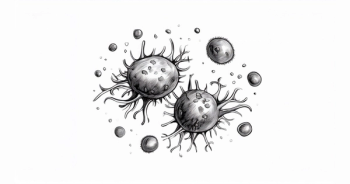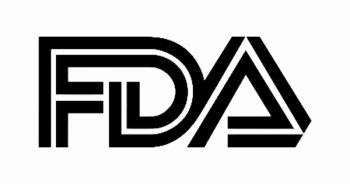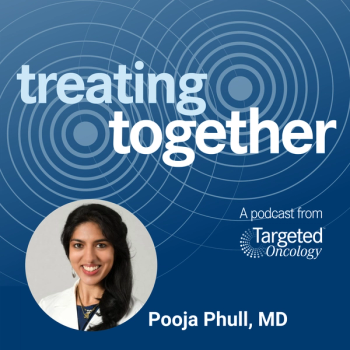
Social, Logistical Barriers Limit Use of CAR T-Cell Therapy in Myeloma
During a live event, Konstantinos Sdrimas, MD, asked participants what community oncologists should consider when referring patients for CAR T-cell therapy.
Chimeric antigen receptor (CAR) T-cell therapy is available for patients with relapsed/refractory multiple myeloma as early as the first relapse, but there are barriers that prevent potentially eligible patients from receiving treatment. In a recent
DISCUSSION QUESTIONS
When considering CAR T-cell therapy:
- What factors should community oncologists consider when deciding whether to refer a patient with multiple myeloma for CAR T at an academic center?
- How do you counsel patients who are referred to a CAR T-cell center? How do those discussions play out?
Donald Fleming, MD: I would [refer for] CAR T-cell therapy, but my concern is you'd probably have to do something before you actually referred for CAR T because it takes a while to get patients processed and there is the so-called vein-to-vein time period. I would think you would have to be something before you send them for CAR T.
Konstantinos Sdrimas, MD: That's a very good point. A lot of the patients in the real world will require some bridging treatment before proceeding with CAR T. Both companies are getting much better with improving their manufacturing time. We don't see the long manufacturing times reported in the trials. There is a movement from both companies to significantly decrease their manufacturing time and they have been very successful on that.
Fleming: I know they used to want us to avoid giving lenalidomide [Revlimid] before autologous stem cell transplant [ASCT]. Is there anything you want us to avoid before sending for CAR T?
Sdrimas: In both trials and in real life, most patients need to be off treatment for at least 2 weeks. The use of steroids is not a good idea, given the fact that we're trying to collect T cells. Most of the patients are able to get a 2-week break from treatment.
Jacob Fuqua, MD: If they had [prior] ASCT, they have a transplanter already involved in their care, so that may expedite some things. But we do see a lot of these people.
Sdrimas: Judging from our experience here at West Virginia University, it's very common that we have transplanted a lot of the patients who we now see for CAR T. [With] bridging treatment, we have to stop the treatment for 2 weeks at least to allow for collection. After collection, we can restart. The amount of treatment that the patient had, or whether the person had ASCT, impacts the collection. However, from the trials and from real-life data, the collection and the manufacturing process is not usually an issue.
That opens the discussion of whether you get healthier T cells when a patient gets CAR T in earlier lines vs later lines. There are a lot of things we don't know yet in that space. Some of the data support that using CAR T in earlier lines is more beneficial than later lines, and one possible explanation for that is that you are dealing with healthier T cells.
DISCUSSION QUESTIONS
- What are the potential roadblocks and challenges for referral of second-line CAR T for early relapsed/refractory multiple myeloma?
- Are there certain patients you would not refer for CAR T-cell therapy in the second-line setting?
Ihtishaam Qazi, MD: Especially in the community setting, it's very rare to get 60-year-old patients. We're usually talking about much older and sicker patients. We send people who are younger and fitter automatically for the consideration of ASCT right after diagnosis. But we have a lot of patients who, due to the rural area they're in, comorbidities, or extreme age, we self-select them out, judging based on upper age limits for ASCT and CAR T. I still think CAR T is as intensive as transplant. We self-select those patients and use all other treatments for them.
Sdrimas: CAR T definitely has its own toxicities, and there are other parameters that play a big role, especially in West Virginia. A lot of the patients may live very far away from an academic center. Although it's a one-and-done treatment, it requires people to be in Morgantown, in our case, for quite some time, but I definitely think it's a much easier process than ASCT. The amount of monitoring that these people require is much less. A lot of the centers, including ours, are doing CAR T as outpatient. There is a trend to be able to send patients home much faster than before. Sometimes people can go back home within 2 weeks from their CAR T. That's a huge thing for a lot of the patients that they go back home within such a limited amount of time.
Toxicities can happen, but the eligibility criteria for a patient to undergo CAR T are much more relaxed than when the patient undergoes ASCT. There are some parameters we need to consider, but I wouldn't preclude the patient from CAR T based on the same criteria that would exclude them for an ASCT. We see more and more data published on older patients who undergo CAR T, and these are very encouraging data.
Damian Silbermins, MD: In this area, unfortunately, insurance is critical. We are 4.5 hours from [West Virginia University] and 3 hours from other places. They need social support. They have to be able to get there. They have to have primary and secondary insurance. Treating myeloma with Medicare only...can bankrupt someone. There are more social barriers. Do the patients want to stay there for weeks? It's a challenge. If they didn't have a good time with the ASCT, it's going to be hard to convince them to go ahead and do [CAR T], especially when you have very effective therapies that we can do locally.
Sdrimas: That’s a very good point. The socioeconomic problems are a real issue. We have ways to try to help with some of these, but it remains a big issue, especially in this area. As I said before, we try to minimize monitoring and allow people to return to their normal activities back home very fast.
The reality is that in multiple myeloma, CAR T is one of many available treatments. It’s not like lymphoma where it's a very different story: CAR T is probably curative for a percentage of those patients and the options are limited. In myeloma, I would also consider CAR T one of the available treatments. That may change with ciltacabtagene autoleucel [cilta-cel; Carvykti], because we see some data that are quite promising, but we need to wait to see how this is going to go.
DISCLOSURES: There were no known relevant disclosures.








































